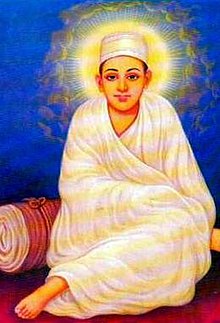Dadu Dayal
This article has multiple issues. Please help improve it or discuss these issues on the talk page. (Learn how and when to remove these template messages)
|
Sant Dadu Dayal Ji | |
|---|---|
 | |
| Personal | |
| Born | 1544 |
| Died | 1603 |
| Religion | Hinduism |
| Sect | Sant Mat |
| Founder of | Dadu Panth |
| Philosophy | Bhakti |
| Religious career | |
| Guru | Bābā Būḍhāu |
| Literary works | Dadu Anubhav Vani |
Sant Dadu Dayal (Devanagari: संत दादूदयाल जी, Saint Dādūdayāl, 1544–1603) was a poet-saint religious reformer who spoke against formalism and priestcraft, and was active in Rajasthan.
Etymology
"Dadu" means brother, and "Dayal" means "the compassionate one".[2]
Life
Dādū Dayāl was born into the Piñjārā/Dhuniyā caste, but later sources attempted to portray him as a Brahmin. According to Jangopāl, he was born in Ahmedabad, but other sources do not attest to this nor did Dādū Dayāl ever have any impact on the city during his lifetime. Dādū Dayāl claimed to have received visions from his guru, Bābā Būḍāu, at the ages of 11 and 18. In 1573, his son Garībdās was born in the town of Sambhar, Rajasthan. His later children include Maskīndās, Havā, and Bāī. According to Jangpāl, his children were born without sexual intercourse with his wife, but according to Rāghavdās they were merely his first four disciples. In Sambhar, Dādū Dayāl is claimed to have had debates with orthodox religious figures, and preached a "middle path" between various sects. By 1579, Dādū Dayāl and his four children/disciples moved to Amber. According to Dādu panthī tradition, Dādū Dayāl visited the court of Akbar on the invitation of Bhagavantdās, Kachvāhā ruler of Amber. He became increasingly nomadic, moving to Karaṛālā, Naraina (where he had received land). In 1603 he died and his body was left in the wilderness.[3]
Dadupanth
It has been suggested that this section be Dadupanth. (Discuss ) (March 2024) |
Dadu Dayal later moved to
Dadupanthis are one of the 7 martial akharas of Vaishnavite sampradaya of Hindus.[5] Vaishnavism has following four major sects:[6]
- Sri founded by Ramananda, Dadupanthis are one of those 7 martial akharas of Vaishnavite in the sec of Ramanada.
- Brahma founded by Madhava.
- Ridra founded by Vishnusuvamin
- Sanakadi founded by Nimbarka.
Followers of Vaishnavism are also called
Dadu Anubhav Vani
Dadu's compositions in
So kāfir jo bolai kāf; |
The infidel is one who tells a lie; |
Dadupanthi Thambas
Dadu had 100 disciples that attained samadhi. He instructed additional 52 disciples to set up ashrams, 'Thambas' around the region to spread the Lord's word.
Dadu ji spent the latter years of his life in Naraiana, a small distance away from the town of Dudu, near Jaipur city.[10]
Five thambas are considered sacred by the followers; Naraiana, Bhairanaji, Sambhar, Amer, and Karadala (Kalyanpura). Followers at these thambas later set up other places of worship.
Dadupanthi Martial Akharas
Armed martial akharas were first likely formed by the Dadupanthi Guru Jait Sahib (1693 - 1734 CE) when he recruited armed Naga
Prominent Dadupanthis
Present status
Dadupanth has continued in Rajasthan to the present-day and has been a major source of early manuscripts containing songs by Dadu and other North Indian saints.[4]
See also
- Akhara
- Bhakti movement
- Sampradaya
- Vaishnavism sampradaya
- Shaivism sampradaya
- Dashanami Sampradaya, a sub-sampradaya of Shaivism
References
- ^ a b Dadu Hindu saint Archived 2 June 2022 at the Wayback Machine at Encyclopædia Britannica Online. Retrieved 31 December 2018.
- ^ "Poet-saint Dadu Dayal". Archived from the original on 5 June 2021. Retrieved 5 June 2021.
- ^ Horstmann, Monika. "Dādū Dayāl". In Jacobsen, Knut A.; Basu, Helene; Malinar, Angelika; Narayanan, Vasudha (eds.). Brill's Encyclopedia of Hinduism Online. Brill.
- ^ a b c Callew 1987, pp. 181–190.
- ^ Dandekar 1987.
- ^ a b David N. Lorenzen, 2006, Who Invented Hinduism: Essays on Religion in History Archived 26 April 2023 at the Wayback Machine, Yoda Press, p.51-65.
- ^ Nayak 1996, p. 96.
- ^ Dadu on Realisation at sahajayoga.org Archived 12 August 2011 at the Wayback Machine
- ^ Upadhaya 1980, p. 10.
- ^ "Temple Profile". Archived from the original on 24 June 2021. Retrieved 18 June 2021.
Sources
- Callew, Winand M. (1987). "Dadu and the Dadu-Panth: The Sources". In Schomer, Karine; McLeod, W. H. (eds.). The Sants: Studies in a Devotional Tradition of India. Berkeley Religious Studies Series. Delhi: OCLC 925707272.
- Dandekar, R. N. (1987) [Rev. ed. 2005]. "Vaiṣṇavism: An Overview". In Eliade, Mircea (ed.). The Encyclopedia of Religion. Vol. 14. New York: MacMillan.
- ISBN 978-0-7914-2025-6.
- Nayak, Sujatha (1996). "Dadu Dayal". In Sivaramkrishna, M.; Roy, S. (eds.). Poet-Saints of India. New Delhi: A Sterling Paperback. pp. 90–100. ISBN 81-207-1883-6.
- Sant Dadu Dayal: Encyclopaedia of Saints Series (Volume 25). Eds. Bakshi, S. R.; Mittra, Sangh (2002). New Delhi: Criterion Publications. ISBN 81-7938-029-7
- Upadhaya, K. N. (1980). Dadu the Compassionate Mystic. Punjab: Radha Soami Satsang Beas.
External links
- Short Notes on Dadu dayal ji
- Dadu Dayal at Kavita Kosh Archived 19 April 2013 at archive.today (Hindi)
- The Biography of Dadu Dayal Archived 30 November 2020 at the Wayback Machine
- Video of the celebration of Dadupanth in Naraina
